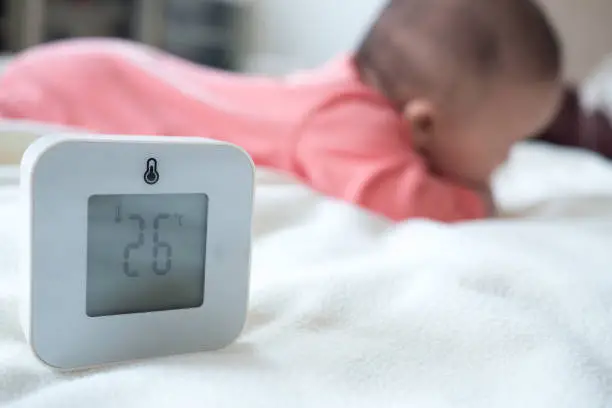Keeping a baby warm at night can be a challenge, especially when it comes to their tiny hands. It’s important to ensure that their hands are warm, as cold hands can be uncomfortable and even lead to sleep disturbances. Fortunately, there are several ways to keep a baby’s hands warm at night.
One way to keep a baby’s hands warm is to use mittens. Mittens are a great option for babies, as they are designed to keep hands warm and prevent heat from escaping. Additionally, mittens can help prevent babies from scratching themselves while they sleep. It’s important to choose mittens that fit properly and are made from soft, breathable materials to ensure maximum comfort.
Another way to keep a baby’s hands warm is to use sleep sacks. Sleep sacks are wearable blankets that can help regulate a baby’s body temperature and keep them warm throughout the night. Some sleep sacks even come with built-in hand covers, which can help keep a baby’s hands warm and prevent them from scratching themselves. When using a sleep sack, it’s important to choose the appropriate size and thickness for the season and to ensure that the baby is dressed appropriately underneath.
- Understanding Baby's Body Temperature
- Importance of Keeping Baby's Hands Warm
- Observing Signs of Overheating and Cold
- Choosing the Right Clothing
- Using Mittens to Keep Hands Warm
- Swaddling Techniques to Keep Hands Warm
- Sleep Sacks and Sleep Sacs for Warmth
- Maintaining Appropriate Room Temperature
- Practices for Cold Winter Nights
- Nursing and Baby's Body Temperature
- Conclusion
- Frequently Asked Questions
- What are some ways to keep a baby's hands warm at night?
- Are sleep sacks with mittens effective in keeping a baby's hands warm?
- How can I keep my 3-month-old's hands warm during sleep?
- What are some tips for keeping a baby warm at night without blankets?
- Is it harmful to keep a baby's hands covered at night?
- What can I do to prevent my baby's hands from getting cold during sleep?
Understanding Baby’s Body Temperature

Maintaining proper body temperature is important for a baby’s health and well-being. Babies have a higher metabolic rate and a larger surface area to body mass ratio than adults, which makes them more susceptible to heat loss. Understanding how a baby’s body temperature works can help parents keep their little ones comfortable and warm at night.
Core Temperature
A baby’s core temperature is the internal temperature of their body. It is regulated by the hypothalamus, a part of the brain that acts as a thermostat. The normal core temperature for a baby is between 97.7°F and 100.4°F (36.5°C and 38°C). When a baby’s core temperature drops below the normal range, they may become cold and shiver. Conversely, when their temperature rises above the normal range, they may become hot and sweaty.
Blood Flow
Babies lose heat through their skin, which means that blood flow is a critical factor in regulating their body temperature. Blood carries heat from the core of the body to the skin, where it can be lost to the environment. When a baby is cold, their body will reduce blood flow to the skin to conserve heat. This can cause their hands and feet to feel cold to the touch.
Cold Hands at Night
It is not uncommon for babies to have cold hands at night, even when the rest of their body feels warm. This is because the hands and feet have a higher surface area to body mass ratio than the rest of the body, which makes them more susceptible to heat loss. Additionally, babies have a lower blood flow to their hands and feet than adults, which can make them feel colder.
Why Does My Baby Have Cold Hands at Night?
There are several reasons why a baby may have cold hands at night. One common reason is that they are not dressed warmly enough. Parents should ensure that their baby is dressed in appropriate clothing for the temperature of the room. Another reason may be that the baby’s sleeping environment is too cold. The room temperature should be between 68°F and 72°F (20°C and 22°C) for optimal sleep. Finally, if the baby is sick or has a fever, their body may be diverting blood flow away from their hands and feet to conserve heat for the core of their body.
Overall, it is important for parents to monitor their baby’s body temperature and adjust their sleeping environment and clothing as necessary to keep them comfortable and warm at night.
Importance of Keeping Baby’s Hands Warm

Newborns and infants are unable to regulate their body temperature as effectively as adults, and they lose heat more quickly. As a result, they are more susceptible to hypothermia, which can be life-threatening. One way to prevent hypothermia is to ensure that the baby’s hands are kept warm, especially during sleep.
When a baby’s hands are cold, it is a sign that their body is losing heat. Cold extremities can lead to discomfort, restlessness, and even waking up in the middle of the night. Therefore, it is crucial to keep your baby’s hands warm to ensure that they stay comfortable and sleep soundly.
Safe sleep guidelines recommend that babies should not be covered with blankets or loose bedding as it increases the risk of Sudden Infant Death Syndrome (SIDS). Therefore, it is essential to find safe and effective ways to keep your baby’s hands warm.
There are several ways to keep your baby’s hands warm without compromising their safety. One option is to dress your baby in warm clothing, such as footed pajamas or a sleep sack. It is also important to ensure that the room temperature is appropriate and not too cold.
In summary, keeping your baby’s hands warm is crucial for their comfort and safety, especially during sleep. By following safe sleep guidelines and dressing your baby appropriately, you can ensure that your baby stays warm and comfortable throughout the night.
Observing Signs of Overheating and Cold

It is important to keep your baby’s hands warm at night, but it is equally important to ensure that they are not overheated or too cold. Overheating can lead to dehydration, heat exhaustion, and even heatstroke, while being too cold can cause hypothermia. Here are some signs to look out for:
Signs of Overheating
- Sweating: If your baby’s skin feels very warm and sweaty, they may be overheated. Be careful when undressing your baby in an air-conditioned room, as they may cool down too fast.
- Rapid breathing: If your baby is breathing rapidly, it may be a sign that they are overheated.
- Red or flushed skin: If your baby’s skin is red or flushed, it may be a sign that they are too hot.
- Irritability: If your baby is fussy or irritable, it may be a sign that they are overheated.
If you notice any of these signs, remove some of the layers your baby is wearing and make sure the room is not too warm. If your baby’s temperature does not go down, contact your pediatrician.
Signs of Frigid Temperatures
- Cold hands and feet: If your baby’s hands and feet feel cold to the touch, they may be too cold.
- Shivering: If your baby is shivering, it may be a sign that they are too cold.
- Blue lips or nails: If your baby’s lips or nails are blue, it may be a sign that they are too cold.
- Lack of energy: If your baby seems lethargic or lacks energy, it may be a sign that they are too cold.
If you notice any of these signs, add an extra layer of clothing or a blanket to keep your baby warm. Make sure the room is not too cold, and avoid using electric blankets or heating pads, which can be dangerous for babies.
Overall, it is important to observe your baby’s signs of overheating or cold to ensure that they are comfortable and safe.
Choosing the Right Clothing

Keeping a baby warm at night starts with choosing the right clothing. Layering is an excellent way to keep babies warm without overheating them. It is essential to dress babies in one layer more than what adults wear to bed.
One option is to use a sleep sack, which is a wearable blanket that covers the baby’s entire body. This helps regulate their body temperature and prevents them from kicking off the covers. A swaddle is another option for babies under two months old. It keeps them snug and warm, mimicking the feeling of being in the womb.
When it comes to clothing, it is best to use soft, breathable fabrics like cotton. Avoid using synthetic materials that can trap heat and make babies uncomfortable. It is also important to check for mitten cuffs on sleepwear to keep babies’ hands warm.
If the sleepwear does not have mitten cuffs, parents can use baby mittens or socks on their hands. Mittens are a great option for keeping babies’ hands warm at night. Even during the colder seasons, it would benefit babies to wear mittens to help prevent heat from escaping their hands.
In conclusion, choosing the right clothing is crucial in keeping babies warm at night. Layering, using breathable fabrics, and checking for mitten cuffs are all important factors to consider. If needed, parents can use baby mittens or socks on their hands to keep them warm.
Using Mittens to Keep Hands Warm
Mittens are a popular choice for keeping baby’s hands warm at night. They are commonly used because they are easy to put on and take off, and they come in a variety of materials such as cotton, wool, and fleece. Additionally, many mittens come with an attached mitten top that can be flipped over the fingers to provide extra warmth.
When choosing mittens for a baby, it is important to consider the material and size. Mittens made of cotton or wool are breathable and can help regulate body temperature, while fleece mittens are soft and cozy. It is also important to choose mittens that fit snugly but not too tightly, as this can restrict blood flow to the hands.
To use mittens to keep baby’s hands warm at night, simply put them on before bedtime. If the mittens have an attached mitten top, flip it over the fingers for extra warmth. It is important to check on baby periodically throughout the night to ensure that the mittens are still on and in place.
While mittens can be effective in keeping baby’s hands warm, it is important to remember that they should not be used as a substitute for proper clothing and bedding. Dressing baby in warm, comfortable pajamas and using a sleep sack or swaddle can also help regulate body temperature and keep baby cozy throughout the night.
In summary, mittens can be a useful tool in keeping baby’s hands warm at night. When choosing mittens, consider the material and size, and make sure they fit snugly but not too tightly. Use them in addition to proper clothing and bedding to ensure baby stays warm and comfortable throughout the night.
Swaddling Techniques to Keep Hands Warm
Swaddling is a popular technique that parents use to keep their babies warm and secure while they sleep. Research shows that swaddling can mimic the coziness of the womb and help calm a baby with colic. Swaddling can also keep your baby’s hands warm at night.
To swaddle your baby, follow these steps:
- Lay a blanket on a flat surface in a diamond shape.
- Fold the top corner down about 6 inches.
- Place your baby on their back with their shoulders on the fold.
- Tuck your baby’s left arm down and across their chest.
- Bring the left corner of the blanket over your baby’s left arm and chest, and tuck it under their back on the right side.
- Tuck your baby’s right arm down and across their chest.
- Bring the bottom corner of the blanket up over your baby’s feet and tuck it into the top of the blanket.
- Bring the right corner of the blanket over your baby’s right arm and chest, and tuck it under their back on the left side.
It’s important to swaddle your baby safely. The American Academy of Pediatrics (AAP) recommends that you swaddle your baby with their arms down, not up. This can help prevent your baby from accidentally covering their face with the blanket and reduce the risk of Sudden Infant Death Syndrome (SIDS).
Additionally, make sure the swaddle is not too tight around your baby’s hips. The swaddle should allow your baby to move their legs freely and not cause any discomfort or pain.
Swaddling can be an effective way to keep your baby’s hands warm at night. When you swaddle your baby, their arms are tucked into the snug swaddle, which can help keep their hands warm. However, if your baby’s hands still feel cold, you can try using mittens or socks to keep them warm.
Overall, swaddling is a safe and effective way to keep your baby warm and secure while they sleep. By following these swaddling techniques, you can help keep your baby’s hands warm and give them a cozy, comfortable sleeping environment.
Sleep Sacks and Sleep Sacs for Warmth
One of the best ways to keep a baby’s hands warm at night is by using a sleep sack or sleep sac. Sleep sacks are wearable blankets that keep babies warm and cozy while they sleep. They are designed to replace loose blankets in the crib, which can be dangerous for babies. Sleep sacks come in different materials, sizes, and designs, but they all serve the same purpose: to keep babies warm and safe.
Polyester fleece sleep sacks are a popular choice for parents who want to keep their babies warm at night. Fleece is a soft and warm material that provides insulation without being too heavy or bulky. Fleece sleep sacks are also easy to care for and can be machine washed and dried. However, it is important to note that some babies may be allergic to polyester, so parents should check for any signs of skin irritation or discomfort.
Another option for parents is to use a sleep sac. A sleep sac is similar to a sleep sack but is made of a different material. Sleep sacs are typically made of cotton or muslin and are designed to be lightweight and breathable. They are ideal for warm weather or for babies who tend to overheat easily. Sleep sacs come in different sizes and designs, and some even have sleeves for added warmth.
When choosing a sleep sack or sleep sac for warmth, parents should consider the size and material of the product. It is important to choose a sleep sack that fits snugly but is not too tight. A sleep sack that is too big can pose a suffocation risk, while one that is too small can be uncomfortable for the baby. Parents should also consider the temperature of the baby’s room and choose a sleep sack that provides the right amount of warmth.
In summary, sleep sacks and sleep sacs are excellent options for parents who want to keep their babies’ hands warm at night. They are safe, comfortable, and come in a variety of materials and designs. Parents should choose a sleep sack or sleep sac that fits well, is made of a suitable material, and provides the right amount of warmth for their baby’s room temperature.
Maintaining Appropriate Room Temperature

Maintaining an appropriate room temperature is crucial to keeping a baby’s hands warm at night. The American Academy of Pediatrics recommends keeping the nursery temperature between 68 and 72 degrees Fahrenheit (20-22 degrees Celsius) to ensure a comfortable sleep environment for babies.
To monitor the room temperature, it is recommended to use a room thermometer. This will help parents ensure that the room temperature is within the recommended range and adjust it if necessary. It is important to note that overheating can be problematic for babies, so it is crucial to keep the room temperature in the appropriate range.
In addition to using a room thermometer, parents can take other measures to maintain an appropriate room temperature. For example, they can use a thermostat to regulate the temperature and prevent it from getting too hot or too cold. They can also check for drafts in the room and use draft stoppers to keep the cold air out.
It is essential to avoid overheating the baby, as this can increase the risk of Sudden Infant Death Syndrome (SIDS). Therefore, parents should take care not to over-bundle the baby with too many blankets or clothing layers. Instead, they can use a baby sleep sack, which is like a wearable blanket that keeps the baby at a comfortable temperature without the risk of suffocation.
In summary, maintaining an appropriate room temperature is essential to keeping a baby’s hands warm at night. Parents can use a room thermometer, a thermostat, and draft stoppers to regulate the temperature and prevent overheating or cold drafts. They should also avoid over-bundling the baby and use a baby sleep sack to keep the baby at a comfortable temperature without the risk of suffocation.
Practices for Cold Winter Nights
Babies can get cold easily, especially during cold winter nights. It is important to keep them warm to ensure they sleep comfortably and soundly. Here are some practices that can help keep a baby’s hands warm at night during the winter season:
Use a Sleeping Bag
Using a sleeping bag can help keep a baby warm throughout the night. It is important to choose a sleeping bag that is appropriate for the temperature of the room. A sleeping bag should not be too tight or too loose, and it should not have any loose fabric that can cover the baby’s face. It is also important to ensure that the baby’s hands are covered by the sleeping bag. Some sleeping bags come with built-in mittens that can help keep the baby’s hands warm.
Dress the Baby Appropriately
Dressing a baby appropriately for the temperature of the room is important to ensure they are warm enough. In colder temperatures, it is recommended to dress the baby in layers. A onesie, a sleep sack, and a warm blanket can help keep a baby warm. It is important to ensure that the baby’s hands are covered by the blanket or sleep sack.
Keep the Room Temperature Optimal
Maintaining a comfortable room temperature is important to keep the baby warm. It is recommended to keep the room temperature between 68-72°F (20-22°C). A room thermometer can be used to monitor the temperature of the room. If the room is cooler than the recommended temperature, a space heater can be used to warm up the room. It is important to ensure that the space heater is placed away from the baby’s sleeping area and is not too hot.
Use a Cooler Humidifier
Using a cooler humidifier can help keep the air in the room moist, which can help prevent the baby’s skin from drying out. Dry skin can make a baby feel colder than they actually are. It is important to ensure that the humidifier is placed away from the baby’s sleeping area and is not too close to any electrical outlets.
In summary, there are several practices that can help keep a baby’s hands warm at night during cold winter nights. Using a sleeping bag, dressing the baby appropriately, maintaining a comfortable room temperature, and using a cooler humidifier can all help keep the baby warm and comfortable throughout the night.
Nursing and Baby’s Body Temperature
When it comes to keeping a baby’s hands warm at night, nursing can play a significant role. Breastfeeding provides warmth and comfort to the baby, which can help regulate their body temperature. Additionally, nursing can help a baby fall asleep faster, which can prevent them from getting too cold while they are awake and restless.
It is important to remember that a baby’s body temperature can fluctuate quickly, and their little hands, ears, and feet are often the first to feel the effects of temperature changes. Therefore, it is crucial to monitor their body temperature and adjust their clothing accordingly.
One way to ensure that a baby’s body temperature is regulated is to dress them in layers. This allows parents to add or remove clothing as needed to keep their baby comfortable. For example, if the room is too warm, parents can remove a layer or two to prevent their baby from overheating. On the other hand, if the room is too cold, parents can add a layer or two to keep their baby warm.
In addition to layers, parents can also use sleep sacks or wearable blankets to keep their baby warm. These products are designed to provide warmth and comfort without the risk of suffocation that comes with traditional blankets.
Overall, nursing and monitoring a baby’s body temperature are crucial for keeping their little hands, ears, and feet warm at night. By dressing them in layers and using sleep sacks, parents can ensure that their baby is comfortable and safe while they sleep.
Conclusion
Keeping a baby’s hands warm at night is important for their comfort and overall well-being. There are several ways to achieve this, including using mittens, sleep sacks, swaddle blankets, and adjusting the room temperature.
Parents should ensure that their baby’s core temperature is normal and not too hot or cold. If they notice cold hands, they can hold their baby close to their chest and wrap them in a blanket until they warm up.
It’s important to avoid using loose blankets or bedding in the crib as they can be a suffocation hazard. Instead, parents can opt for sleep sacks or swaddle blankets to keep their baby warm.
Mittens can also be a good option for keeping a baby’s hands warm, especially during colder seasons. However, parents should ensure that the mittens fit properly and are not too tight, as this can restrict blood flow and cause discomfort.
Overall, there are many safe and effective ways to keep a baby’s hands warm at night. Parents should choose the method that works best for their baby and ensure that they are comfortable and safe throughout the night.
Frequently Asked Questions
What are some ways to keep a baby’s hands warm at night?
There are several ways to keep a baby’s hands warm at night. One option is to use mittens or gloves specifically designed for babies. These can be found at baby stores or online. Another option is to use sleep sacks with attached mittens or built-in hand covers. Additionally, parents can layer their baby’s clothing to provide extra warmth.
Are sleep sacks with mittens effective in keeping a baby’s hands warm?
Yes, sleep sacks with mittens can be effective in keeping a baby’s hands warm. These sleep sacks are designed to keep the baby’s hands covered and warm, while still allowing them to move their arms and hands freely.
How can I keep my 3-month-old’s hands warm during sleep?
To keep a 3-month-old’s hands warm during sleep, parents can use mittens or gloves designed for babies, layer their clothing, or use a sleep sack with attached mittens. It is important to ensure that the baby is not overheated, as this can be dangerous.
What are some tips for keeping a baby warm at night without blankets?
If parents prefer not to use blankets, there are several ways to keep a baby warm at night. They can use sleep sacks with built-in hand covers or layer their baby’s clothing. Additionally, they can keep the room at a comfortable temperature, between 68 and 72 degrees Fahrenheit, and use a humidifier to prevent dry air.
Is it harmful to keep a baby’s hands covered at night?
It is not harmful to keep a baby’s hands covered at night, as long as the baby is not overheated. However, it is important to ensure that the baby can move their arms and hands freely, and that the covering does not pose a suffocation hazard.
What can I do to prevent my baby’s hands from getting cold during sleep?
To prevent a baby’s hands from getting cold during sleep, parents can use mittens or gloves designed for babies, layer their clothing, or use a sleep sack with attached mittens. Additionally, they can ensure that the baby’s room is at a comfortable temperature and use a humidifier to prevent dry air.




